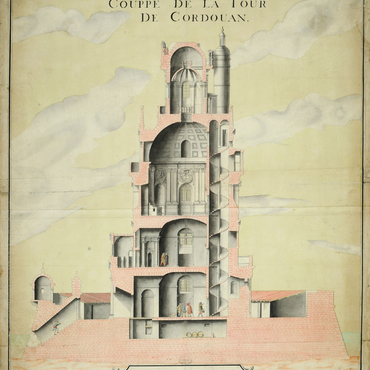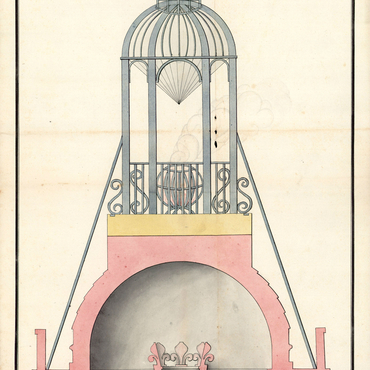
- Home
- A Renaissance monument
- The monarchy and the lighthouses of the 17th century
- Lighting the way with iron and coal
At first, the Cordouan lighthouse and the Baleines fire tower burned oil placed in a stone lantern. The light given off by these lamps – which were placed behind thick, sooty pieces of glass separated by thick stone piers – was quite feeble. At Cordouan, the stone lantern had become so charred by the burning oil that there was a risk that it would collapse, and in 1717 it was decided to demolish it and to burn coal instead of oil. The choice of a coal fire, which had been suggested by Vauban in the late seventeenth century, was inspired by English beacons. Coal was used at the Stiff lighthouse in Ouessant, and starting in 1716, for the two towers at Chassiron. A new iron coal burner, inspired by one in the lighthouse on the island of Texel in the United Provinces, was specially built for Chassiron. It was copied at Cordouan. Each night that it was lit, the burner consumed between 100 and 150 kg of coal, which the keeper had to haul up to the top of the tower in a basket. Bitry, the engineer of the fortifications at Bordeax, designed an iron lantern for the new light at Cordouan. It was forged in the department of Berry, assembled by a locksmith in Nevers, and shipped by river and sea all the way to Cordouan. It was 15 pieds tall (5 metres) and was 8 pieds in diameter (2.7 metres), and it was lit in 1727. Operating the lighthouses demanded long-distance logistics. The coal came from England, Brittany and central France (Decize, Saint-Étienne). At Royan, Bitry transformed a private home into a warehouse capable of holding several months' worth of coal. Following in Cordouan's footsteps, the Baleines lighthouse adopted the "iron and coal" system in 1736. A lantern was installed at Stiff in 1740; spurred by the royal engineers, the operation of the kingdom's lighthouses became more standardised.
Associated media
Open Media Library

Cross-section of Cordouan, 1722

Drawings of Cordouan's iron lantern as it appeared in 1727

Elevation of the Cordouan tower

Elevation of the Cordouan tower

Cross-section of the tower with the new iron lantern, eighteenth century.

Restitution of Cordouan Lighthouse, 1727
